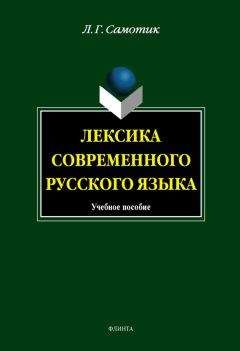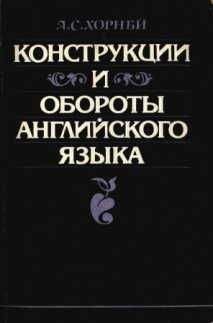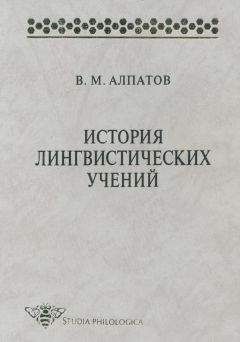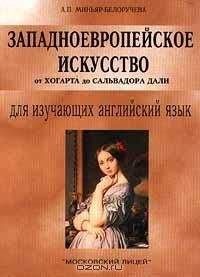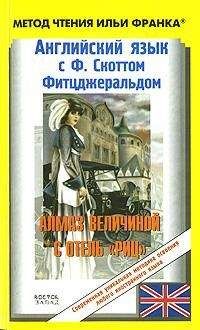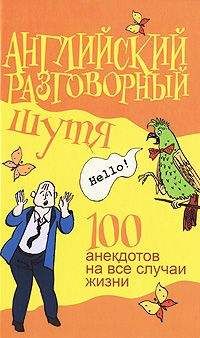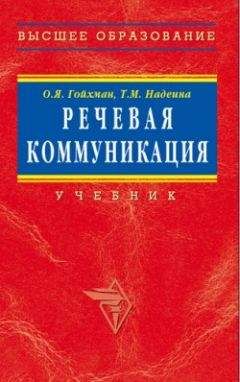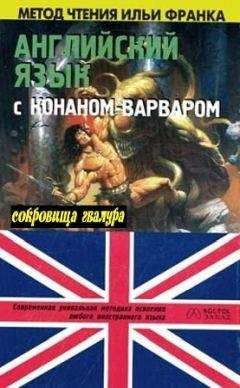А. Миньяр-Белоручева - Западноевропейское искусство от Джотто до Рембрандта
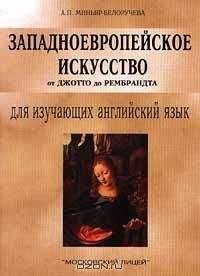
Скачивание начинается... Если скачивание не началось автоматически, пожалуйста нажмите на эту ссылку.
Жалоба
Напишите нам, и мы в срочном порядке примем меры.
Описание книги "Западноевропейское искусство от Джотто до Рембрандта"
Описание и краткое содержание "Западноевропейское искусство от Джотто до Рембрандта" читать бесплатно онлайн.
Тексты настоящего пособия охватывают пять веков западноевропейской живописи от Джотто до Рембрандта. Это дает возможность обучаемым приобрести не только лингвистические знания, усвоив обширный лексический материал, но и культурологические, поскольку последовательный хронологический переход текстов от одного художника к другому позволяет создать более или менее целостную картину развития западноевропейской искусства с XIII по XVII вв. Система упражнений направлена на усвоение лексического материала и развитие навыков устной речи.
Данная книга является первой частью цикла учебных пособий для изучающих английский язык и предназначена для студентов-искусствоведов, учащихся классических гимназий, лицеистов и всех интересующихся искусством.
Учебный центр «Московский Лицей»
пособие для изучающих английский язык
издание второе переработанное и дополненное
Москва -1999
Рецензенты:
И. И. Малинина кандидат филологических наук
Н. В. Васютина кандидат филологических наук
РЕКОМЕНДОВАНО кафедрой иностранных языков исторического факультета МГУ им. М. В. Ломоносова
Искусство Рубенса – типичное выражение барокко. Художник часто писал картины на сюжеты античных мифов. Рубенс оказал большое влияние на последующее развитие западноевропейского искусства.
VI. Summarize the text.
VII. Topics for discussion.
1. Rubens's mode of life and production system.
2. Rubens's style and characters.
3. Rubens as a Baroque painter.
Unit XIII Velazquez (1599-1660)
Diego Rodriguez de Silva у Velazquez was the greatest Spanish painter. Born in Seville, Velazquez studied with the local Mannerist Francisco Pacheco. In 1623 Velazquez was appointed court painter and settled permanently in Madrid. By 1627 he was established in the royal household and got the rank of court chamberlain. It gave him a residence attached to the palace and a studio inside it. For more than 30 years Velazquez painted King Philip iv and members of the royal family and court, produced historical, mythological, and religious pictures. His paintings were influenced by Rubens and the Venetian artists.
Velazquez never deserted the integrity of his own style. He did not adopt the characteristic devices of allegorical figures, columns, curtains of boiling clouds utilized by most Catholic painters of the seventeenth century. Velazquez was attached to nature.
He visited Italy twice and expressed a frank dislike for Raphael and thus for the Italian idealism. Velazquez admired Titian and copied Tintoretto as an exercise in freedom of the brush. Throughout his life Velazquez was deeply concerned with the principles of composition and design.
When Caravaggesques realism penetrated Spain, it was felt by the young Velazquez as a liberation. Velazquez's interpretation of this movement was original. His Triumph of Bacchus, of about 1628, contains numerous reminiscences of Titian's Bacchanal of the Andrians, reinterpreted in basically Caravaggesques terms. Bacchus is a rather soft Spanish youth, with a towel and a cloak around his waist, as if he had just climbed out of a neighbouring stream. Crowned with wine leaves himself he mischievously puts a crown upon a kneeling worshiper, who is a simple Spanish peasant. Other peasants are gathered around. One peasant with bristling moustache and a hat pushed back hands a cup of wine toward a spectator, while another tries to grab it. The proletarian invitation to join in the delights of wine is painted with a brilliance unequalled by any other Latin painter of the seventeenth century. Yet the emphasis of the solidity of flesh and rough clothing shows that Velazquez is a Mediterranean painter.
The Surrender of Breda, of 1635, is a magnificent painting. It is remarkable for its excellent equilibrium. The groups of Spanish victors and defeated Dutchmen are scrupulously equalized. The surrender is carried out with dignity unlike in the conventional representations of the glorification of the victors and the disgrace of the conquered.
After the second trip to Italy (1649-51) Velazquez painted his most complex imaginary picture, based on the myth of Arachne, The Weavers, c.1656. The central scene, the moment when Minerva turns Arachne, a mortal girl who challenged the goddess of spinning and weaving to a contest, into a spider — is depicted in the background. In the foreground the weaver's workroom is produced so convincingly that in later centuries this painting was taken for a large genre scene. The emotion of the workshop, the spinning of the wheel, the handling of the tale as an ordinary event, make this painting one of the most outstanding of Velazquez's mythological works.
Velazquez's masterpiece, and one of the most extraordinary paintings of the seventeenth century is Las Meninas (The Ladies-in-waiting), of 1656. It was initially titled The Portrait of the Family. The painter is depicted in his studio in the royal palace, at work upon a canvas, so large that it can only be this very picture, unique in scale in his entire production. In the centre the light falls on the glittering figure of the five-year-old princess, who has paid the painter a visit, accompanied by two ladies-in-waiting, one of whom kneels to give her a cup of water. On the right two dwarfs are portrayed; one is gently teasing with his foot an elderly dog. Through the open door in the background wall light falls on a court official, pausing for a moment, on the steps. Most important of all the mirror alongside the door reflects the King and Queen. who also honour the painter with their presence. Despite the apparent ease and informality of the subject, the picture is carefully balanced in a series of interlocking pyramids that can be ranked with the greatest designs of the Renaissance. In light and dark the illusion of the picture is as real as the intimate and quiet mood. Velazquez's brush suggests the reality of objects through the sparks and reflections of light on hair, silk, flowers and embroidery, spots of light and colour set down by touches of the brush create the illusion of form. Las Meninas is the culmination of Velazquez's work. In this painting the artist demonstrates to all time the nobility of his art – a rank that no king can award.
Velazquez had no immediate followers, but the painters of succeeding centuries such as Goya and Manet highly esteemed him.
Make sure you know how to pronounce the following words:
Velazquez; Madrid; Seville; Philip; Mediterranean; crown; Order; Santiago; Chamberlain; Arachne; Goya; Manet
NotesTriumph of Bacchus – «Вакх»
Surrender of Breda – «Сдача Бреды»
The Weavers – «Пряхи»
Las Meninas – «Менины»
TasksI. Read the text. Make sure you understand it. Mark the following statements true or false
1. For twenty years Velazquez painted King Philip iv and members of the royal family and court.
2. Velazquez adopted the characteristic machinery of allegorical figures, utilized by most Catholic painters of the seventeenth century.
3. Velazquez's Triumph of Bacchus contains numerous reminiscences of the Nertherlandish masters.
4. The Surrender of Breda is a work of universal importance.
5. In The Weavers the central scene is depicted in the foreground.
6. In Las Meninas Velazquez shows the nobility of his art.
II. How well have you read? Can you answer the following questions?
1. Where was Velazquez trained? What position did he obtain at the court?
2. Whose works did Velazquez distaste and whose paintings did he admire? What did Caravaggesques realism mean to Velazquez?
3. What did Velazquez depict in the Triumph of Bacchus? What shows that Velazquez is a Mediterranean painter?
4. What is pictured in the Surrender of Breda? In what way does it differ from other pictures of this kind?
5. What makes The Weavers Velazquez's most complex allegorical painting? What legend was the basis of this work of art?
6. What does Las Meninas portray? What makes Las Meninas Velazquez's masterpiece? What are the figures depicted in this picture doing? What is Las Meninas (a group portrait, a self-portrait or a genre painting)?
III. I. Give Russian equivalents of the following phrases:
to be appointed court painter; to settle permanently in; royal household; to get the rank of; Court Chamberlain; a residence attached to the palace; members of the royal family and court; the integrity of one's style; the characteristic devices; allegorical figures; to be attached to nature; freedom of the brush; throughout the life; principles of composition; Caravaggesques realism; numerous reminiscences; a Mediterranean painter; to fall under the influence of; the studio in the royal palace; to work upon a canvas; to create the illusion of form unique in scale; to pay the painter a visit; dwarfs; to honour the painter with the presence; informality of the subject; interlocking pyramids.
II. Give English equivalents of the following phrases:
целостность стиля; иллюзия формы; члены королевской семьи и двора; принципы композиции и рисунка; предшествующий век; получить должность; придворный художник; ряд пересекающихся пирамид; карлики; в светотени; аллегорические образы; типичные атрибуты; гофмейстер; свобода мазка; многочисленные цитаты из; постоянно поселиться в; трактовка направления; средиземноморский художник; уникальная по масштабу картина; почтить своим присутствием студию художника.
III. Make up sentences ofyour own with the given phrases.
IV. Arrange the following in the pairs of synonyms:
a) local; court; trip; interpret; supreme; reminiscences; dwarfs; demonstrate; appoint; attain;
b) royal household; render; exquisite; quotations; Lilliputians; show; place; gain; journey; native.
IV. Here are descriptions of some of Velazquez's works of art. Match them up to the given titles…
1. The mirror alongside the door re- flects the King and Queen, who honour the painter with their presence.
2. Crowned with wine leaves himself he mischievously puts a crown upon a kneeling worshiper.
3. The painting is noted for its clas- sical equilibrium.
4. This painting is one of the most significant of Velazquez's mythological works.
a. Triumph of Bacchus
b. Surrender of Breda
c. The Weavers
d. Las Meninas
V. Translate the text into English.
Диего Родригос де Сильва Веласкес – выдающийся художник «золотого испанского века», родился в Севилье, учился у местного художника Франсиско Пачеко.
В 1626 г. Веласкес переехал в Мадрид и стал придворным художником короля Филиппа IV. В 1627 г. художник получил звание гофмейстера. После знакомства с Рубенсом, который посетил Испанию в 1628 г. Веласкес отправился в Италию, где провел три года. Работы итальянских художников оказали большое влияние на Веласкеса. Его стиль стал более свободным и блестящим, колорит менее темным в тенях.
В конце 20-х годов Веласкес написал картину «Вакх». Эту мифологическую сцену он интерпретировал как жанровую. Идеализации нет даже в фигуре самого Вакха. Контрасты света и тени, золотистый тон – все типичные черты караваджизма, переплетаются с характерными только для Веласкеса чертами.
В последнее десятилетие жизни художник написал три самых известных картины: «Венера с зеркалом», «Менины», «Пряхи». «Менины» – это, по своей сути, групповой портрет. Художник, а это автопортрет самого Веласкеса, у мольберта пишет короля и королеву, отражение которых зрители видят в зеркале. На переднем плане изображена инфанта Маргарита в окружении фрейлин, карлицы, придворных и собаки. В дверях художник поместил фигуру канцлера. Композиция картины объединяет черты группового портрета и жанровой картины. Влияние Веласкеса на искусство последующих веков велико. Он вдохновлял художников от романтиков до постимпрессионистов.
VI. Summarize the text.
VII. Topics for discussion.
1. Velazquez's realism.
2. Velazquez's artistic heritage.
Unit XIV The 'Little Masters'
The open market system, under which Dutch pictures were sold, produced artists skilful in painting a particular type of subject. They specialized in landscapes, riverscapes, seascapes, city-scapes, travelscapes; skating scenes, moonlight scenes, shipping and naval battles; interiors, exteriors; gardens, polite conversations, parlour intrigue, housekeeping, tavern brawls; hunting scenes, churches, still lifes and portraits, single, double, or group.
At least forty of the 'little masters' are very talented.
An early leader of Dutch landscape painting, Jan van Goyen (1596-1656), was one of the Dutch masters to place human figures to a position in which they could no longer determine the mood of a scene but merely establish the scale. Van Goyen was fascinated by water. But the celestial architecture of shifting clouds was even more important than water in his landscapes. In River Scene, painted by Van Goyen shortly before his death, the land with fishermen's cottages, windmills, and a distant church, is visible only in tiny patches. All else is clouds and water, save for two boats moving slowly toward the centre. People are mere spots, as are the flying gulls. An almost monochromatic vision, limited to translucent browns in the foreground and grey greens elsewhere, is registered by means of light, shimmering water, and distant land.
A View of Haarlem, of about 1670, by Jacob van Ruisdael (1628/29-82), opens up an immense prospect from the vantage point of the dunes. The city appears only on the flat horizon, a sparkle of windmills and spires is dominated by the mass of the Great Church. The immensity of the space is increased by the light falling from between clouds on the farmhouses and the linens whitening in the foreground. The birds fly higher and the clouds seem more remote than in Van Goyen's picture.
One of the greatest Dutch landscapes is the Avenue at Middelbarnis, of 1689, by Meyndert Hobbema (1638-1709), Ruisdael's pupil. Constructed on the humble theme of a rutted country road plunging into the picture between feathery trees that have long lost lower branches for use as firewood, the spatial climax is compelling.
Подписывайтесь на наши страницы в социальных сетях.
Будьте в курсе последних книжных новинок, комментируйте, обсуждайте. Мы ждём Вас!
Похожие книги на "Западноевропейское искусство от Джотто до Рембрандта"
Книги похожие на "Западноевропейское искусство от Джотто до Рембрандта" читать онлайн или скачать бесплатно полные версии.
Мы рекомендуем Вам зарегистрироваться либо войти на сайт под своим именем.
Отзывы о "А. Миньяр-Белоручева - Западноевропейское искусство от Джотто до Рембрандта"
Отзывы читателей о книге "Западноевропейское искусство от Джотто до Рембрандта", комментарии и мнения людей о произведении.








